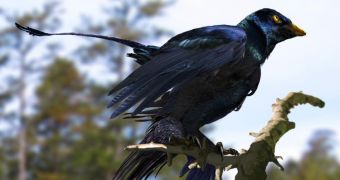Researchers at the University of Texas in Austin (UT-Austin) say that the latest analysis of a Microraptor fossil reveals that the ancient, four-winged dinosaur featured iridescent plumage, possibly for the purpose of attracting mates.
The creature lived more than 120 million years ago, and was about the size of a modern-day pigeon. However, pigeons are not exactly known for their ability to fly around propelled by four wings.
What intrigues researchers about this particular species is the fact that a pair of streamer feathers appears to have adorned the narrow tail of Microraptors. This may suggest that feather displays were important even at that time.
Modern birds use songs and feathers to attract mates, and many scientists now believe that even their earliest ancestors displayed similar behaviors. Details of the new investigation were published in this week's issue of the top journal Science.
With this discovery, Microraptor becomes the earliest known species in the world to have sported iridescent colors on its feathers. According to UTA scientists, the feathers on this dinosaur were similar to that of a modern crow, boasting iridescent colors covered by a glossy sheen.
One of the things that experts can do now is proceed with reconstructing the dinosaur as a whole. This may help settle a long-running debate about how the ancient lizards moved from terrestrial locomotion to flight.
“Specifying the color and iridescence of feathers in avian dinosaurs was not possible 20 years ago. This development, in combination with the arrangement of tail feathers, is leading to a deeper understanding of the early development of avian plumage signaling,” H. Richard Lane explains.
The expert holds an appointment as a program director with the Division of Earth Sciences (DES), at the US National Science Foundation (NSF). The organization funded the new UT-Austin study.
Lane adds that Microraptor has been heavily investigated since it was first discovered, back in 2003, primarily because of its potential to explain how both feathers and flight evolved so long ago.
“Most aspects of early dinosaur feathering continue to be interpreted as fundamentally aerodynamic, optimized for some aspect of aerial locomotion,” UT-Austin paleontologist and study co-author, Julia Clarke, explains.
“Some of these structures were clearly ancestral characteristics that arose for other functions and stuck around, while others may be linked to display behaviors or signaling of mate quality,” the expert concludes.

 14 DAY TRIAL //
14 DAY TRIAL //